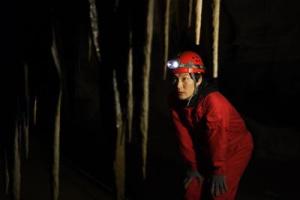Jun 19 2014
Korean research team revealed conflicting climate change patterns between the middle latitude areas of the Northern and Southern Hemispheres in relation to glacial and interglacial cycles which have been puzzled for the past 60 years.
 Doctor Kyoung-nam Jo from the Korea Institute of Geoscience and Mineral Resources is explaining his research details while watching the section of a stalagmite in the Baekryong Cave in Pyeongchang, Kangwon Province. (Credit: Korea Institute of Geoscience and Mineral Resources)
Doctor Kyoung-nam Jo from the Korea Institute of Geoscience and Mineral Resources is explaining his research details while watching the section of a stalagmite in the Baekryong Cave in Pyeongchang, Kangwon Province. (Credit: Korea Institute of Geoscience and Mineral Resources)
Doctor Kyoung-nam Jo from the Quaternary Geology Department of the Korea Institute of Geoscience and Mineral Resources(KIGAM) revealed a clue for solving the riddle of past global climate change in his paper titled 'Mid-latitudinal interhemispheric hydrologic seesaw over the past 550,000 years' which was featured in the journal Nature.
This study collected samples from the stalagmites and flowstones in limestone caves which are called 'hard disks' containing the past climate change data and revealed how much they grew in which eras through isotope analysis and age dating, and traced the past climate changes by applying them to global climate change over 550,000 years.
For this study, Doctor Jo explored over 200 caves in Korea and collected 24 samples from stalagmites and flowstones in 15 limestone caves. As a result of analyzing the growth through U-series age dating, it was found that they grew well during interglacial eras when it was warm and moist, whereas their growth stagnated during glacial eras. By comparing this data with existing external climate change data which were obtained from solar insolation, glaciers, and deep sea sediments, he found that the same climate change phenomena appeared in the same periods.
In particular, he and colleagues revealed the fact that climate changes in the Northern and Southern Hemispheres showed opposite tendencies by analyzing the fact that stalagmites and flowstones in the temperate zones of the Northern and Southern Hemispheres had opposite growth periods. This suggests for the first time that the so-called phenomenon of the interhemispheric hydrological seesaw that the precipitation changes in the tropical regions show opposing tendencies between Northern and Southern Hemispheres had been spread to the temperate region in which the Korean peninsula was located at least for the last 550,000 years.
Due to the interhemispheric hydrological seesaw, when it rains frequently in a region that belongs to the intertropical convergence zone (ITCZ), it accelerates the growth of plants and increases the temperature, whereas other areas exhibit cold dry weather. This theory has been applied only to the tropical region and had not been significance in global climate change. However, if it is expanded to the temperate regions by the study of Doctor Jo, the seesaw phenomenon may be regarded as another key factor besides the insolation change which has been regarded as the most powerful factor in the glacial and interglacial cycles.
The findings of this study are attracting very keen interest from academic circles because they can be used to explain past climate change and predict future climate change. In particular, as the different climate change mechanisms by region were revealed, it is expected that a more accurate global climate change model could be created.
Doctor Jo said, "Geology research such as ancient climate research is usually regarded as something that is distant from our daily lives, but it is the only way to understand the effects of large-scale climate changes that actually happened in the past. In order to more accurately assess serious climate change events and the impacts that human beings will experience, it is essential to continuously discuss with domestic scholars as well as to participate in large-scale international joint research programs such as the IODP(International Ocean Discovery Program).